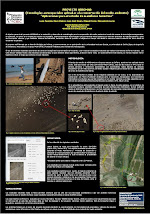

A study by the Spanish National Research Council (CSIC) has used small unmanned aerial
systems (SUASs) to reproduce the flight paths of birds of prey and get environmental
information of their hunting areas.
One of the main limitations of biotelemetry (remote measurement of physiological, behavioral
or environmental data) of wild birds is the small size and weight of most species. Therefore,
the limited information available so far is biased towards larger birds. In this paper, published
in PLoS ONE journal, we describe the combined use of light weight GPS data-loggers and
environmental information gathered by unmanned aerial systems.


The study was performed using as a model species the Lesser Kestrel (Falco naumanni), one
of the smallest raptors of Europe. It took place in the newly established colony on the roof of
the headquarters of the Doñana Biological Station (CSIC) in Seville. The birds, marked with
a 5 grams GPS data-logger are wild and move freely, with the particularity that they nest in
facilities that were built expressly for them in an urban environment. After downloading the
geographic coordinates recorded by the GPS of the places visited by kestrels in the vicinity of
Seville, the SUASs were programmed to reproduce the flights carried out by the birds. During
the flight of the aircraft, an onboard camera took high-resolution digital photos of the areas
overflown.
This methodology allows to extract environmental information in nearly real time, showing that
SUASs are a useful tool for a wide variety of wildlife studies.
The study was funded by the Junta de Andalucia Excellence Projects AEROMAB (P07-RNM-
03246) and Horus (P09-RNM-04588) and by the European Commission through the project
PLANET (7th EC FP Grant Agreement 257,649).
A. Rodríguez, J.J. Negro, M. Mulero, C. Rodríguez, J. Henández-Pliego, J. Bustamante. The eye
in the sky: combined used of unmanned aerial systems and GPS data-loggers
for ecological research and conservation of small birds. PLoS ONE http://dx.plos.org/10.1371/
journal.pone.0050336
Download .pdf: http://dx.plos.org/10.1371/journal.pone.0050336


 A study by the Spanish National Research Council (CSIC) has used small unmanned aerial
systems (SUASs) to reproduce the flight paths of birds of prey and get environmental
information of their hunting areas.
One of the main limitations of biotelemetry (remote measurement of physiological, behavioral
or environmental data) of wild birds is the small size and weight of most species. Therefore,
the limited information available so far is biased towards larger birds. In this paper, published
in PLoS ONE journal, we describe the combined use of light weight GPS data-loggers and
environmental information gathered by unmanned aerial systems.
A study by the Spanish National Research Council (CSIC) has used small unmanned aerial
systems (SUASs) to reproduce the flight paths of birds of prey and get environmental
information of their hunting areas.
One of the main limitations of biotelemetry (remote measurement of physiological, behavioral
or environmental data) of wild birds is the small size and weight of most species. Therefore,
the limited information available so far is biased towards larger birds. In this paper, published
in PLoS ONE journal, we describe the combined use of light weight GPS data-loggers and
environmental information gathered by unmanned aerial systems.
 The study was performed using as a model species the Lesser Kestrel (Falco naumanni), one
of the smallest raptors of Europe. It took place in the newly established colony on the roof of
the headquarters of the Doñana Biological Station (CSIC) in Seville. The birds, marked with
a 5 grams GPS data-logger are wild and move freely, with the particularity that they nest in
facilities that were built expressly for them in an urban environment. After downloading the
geographic coordinates recorded by the GPS of the places visited by kestrels in the vicinity of
Seville, the SUASs were programmed to reproduce the flights carried out by the birds. During
the flight of the aircraft, an onboard camera took high-resolution digital photos of the areas
overflown.
This methodology allows to extract environmental information in nearly real time, showing that
SUASs are a useful tool for a wide variety of wildlife studies.
The study was funded by the Junta de Andalucia Excellence Projects AEROMAB (P07-RNM-
03246) and Horus (P09-RNM-04588) and by the European Commission through the project
PLANET (7th EC FP Grant Agreement 257,649).
A. Rodríguez, J.J. Negro, M. Mulero, C. Rodríguez, J. Henández-Pliego, J. Bustamante. The eye
in the sky: combined used of unmanned aerial systems and GPS data-loggers
for ecological research and conservation of small birds. PLoS ONE http://dx.plos.org/10.1371/
journal.pone.0050336
Download .pdf: http://dx.plos.org/10.1371/journal.pone.0050336
The study was performed using as a model species the Lesser Kestrel (Falco naumanni), one
of the smallest raptors of Europe. It took place in the newly established colony on the roof of
the headquarters of the Doñana Biological Station (CSIC) in Seville. The birds, marked with
a 5 grams GPS data-logger are wild and move freely, with the particularity that they nest in
facilities that were built expressly for them in an urban environment. After downloading the
geographic coordinates recorded by the GPS of the places visited by kestrels in the vicinity of
Seville, the SUASs were programmed to reproduce the flights carried out by the birds. During
the flight of the aircraft, an onboard camera took high-resolution digital photos of the areas
overflown.
This methodology allows to extract environmental information in nearly real time, showing that
SUASs are a useful tool for a wide variety of wildlife studies.
The study was funded by the Junta de Andalucia Excellence Projects AEROMAB (P07-RNM-
03246) and Horus (P09-RNM-04588) and by the European Commission through the project
PLANET (7th EC FP Grant Agreement 257,649).
A. Rodríguez, J.J. Negro, M. Mulero, C. Rodríguez, J. Henández-Pliego, J. Bustamante. The eye
in the sky: combined used of unmanned aerial systems and GPS data-loggers
for ecological research and conservation of small birds. PLoS ONE http://dx.plos.org/10.1371/
journal.pone.0050336
Download .pdf: http://dx.plos.org/10.1371/journal.pone.0050336


No comments:
Post a Comment